What Is Brand Storytelling?
Brand storytelling utilizes narratives to forge emotional connections between companies and their customers. When brands tell compelling stories about their products, people connect on a personal level. They begin to understand what the company stands for, why the brand exists, and what makes it matter. This emotional connection transforms casual buyers into loyal advocates who care about more than just the product itself.
Think of it as building a friendship rather than making a transaction. Great brands share their origin stories, detailing their beginnings, struggles, victories, and purpose. These foundational narratives help customers see themselves in the brand's journey. Whether it's joy, nostalgia, inspiration, or determination, stories tap into emotions that create lasting impressions.
The key is understanding what story you want to tell. Are you demonstrating how your brand stands out from competitors? What values drive your company? What do you want people to feel when they think of your business? Remember, in compelling brand storytelling, the customer is the main character—the hero whose experience or problem your brand helps to resolve. These answers shape the narratives you'll share.
Once you know your story, you can bring it to life through engaging content. This might include creative writing about your company's history, behind-the-scenes glimpses into your team, or customer testimonials that showcase real impact. Pair these stories with visuals, such as photos, videos, and infographics, to make them even more powerful.
Brand Story Elements

The Power of Brand Story
A strong brand story captivates and inspires your target audience. It sets your brand apart from competitors and creates emotional connections that foster loyalty and trust. Storytelling is a powerful tool for building emotional connections and differentiating your brand. These narratives make your brand more memorable and relatable in ways that product specifications never could.
In today's digital world, a compelling brand story is no longer optional. It's essential for any successful marketing strategy. Stories give people a reason to care about your business beyond the features you offer.
Why Brand Storytelling Is Important
Boosts Brand Awareness and Engages the Audience
According to a Corporate Executive Board (CEB) report, brand storytelling enables transmedia storytelling and can increase the worth of a product or service by up to 20 times more than just stating its features and advantages.
Brand storytelling is important for businesses because it can increase awareness of the brand and construct brand narrative that establishes closer relationships with the audience.
Companies that apply storytelling techniques and make users’ stories emotionally appealing have an opportunity to create a strong bond with their customers. This is critical, considering several choices available to consumers today within the digital era.
Regarding your target audience, storytelling helps build an image for your business. By showing why they are different from others while writing engaging content and developing brand narrative, companies can show why they matter. This process structures storytelling framework to maximize impact.
Brand Story

Creates Loyalty and Trust
Brand storytelling is about designing brand narrative to build brand loyalty and building loyalty and trust with customers. Understanding why a brand exists is fundamental to shaping this narrative. This approach establishes storytelling framework that resonates with your audience.
For example, it involves frequently engaging in conversations with the target audience through relevant content. In addition, storytelling develops narrative strategy to offer different meanings of their brand’s values compared to competitors.
Businesses can construct brand narrative that causes a return effect by strong, informative, emotionally charged stories. The emotional connection becomes stronger when people know more about the company’s past and significant moments and some personal life details of its employees.
As such, customers develop deep personal connections with organizations, which help them understand their motives and objectives, thus leading to trust and loyalty. This connection shapes narrative design approach that builds lasting relationships.
Brand trust
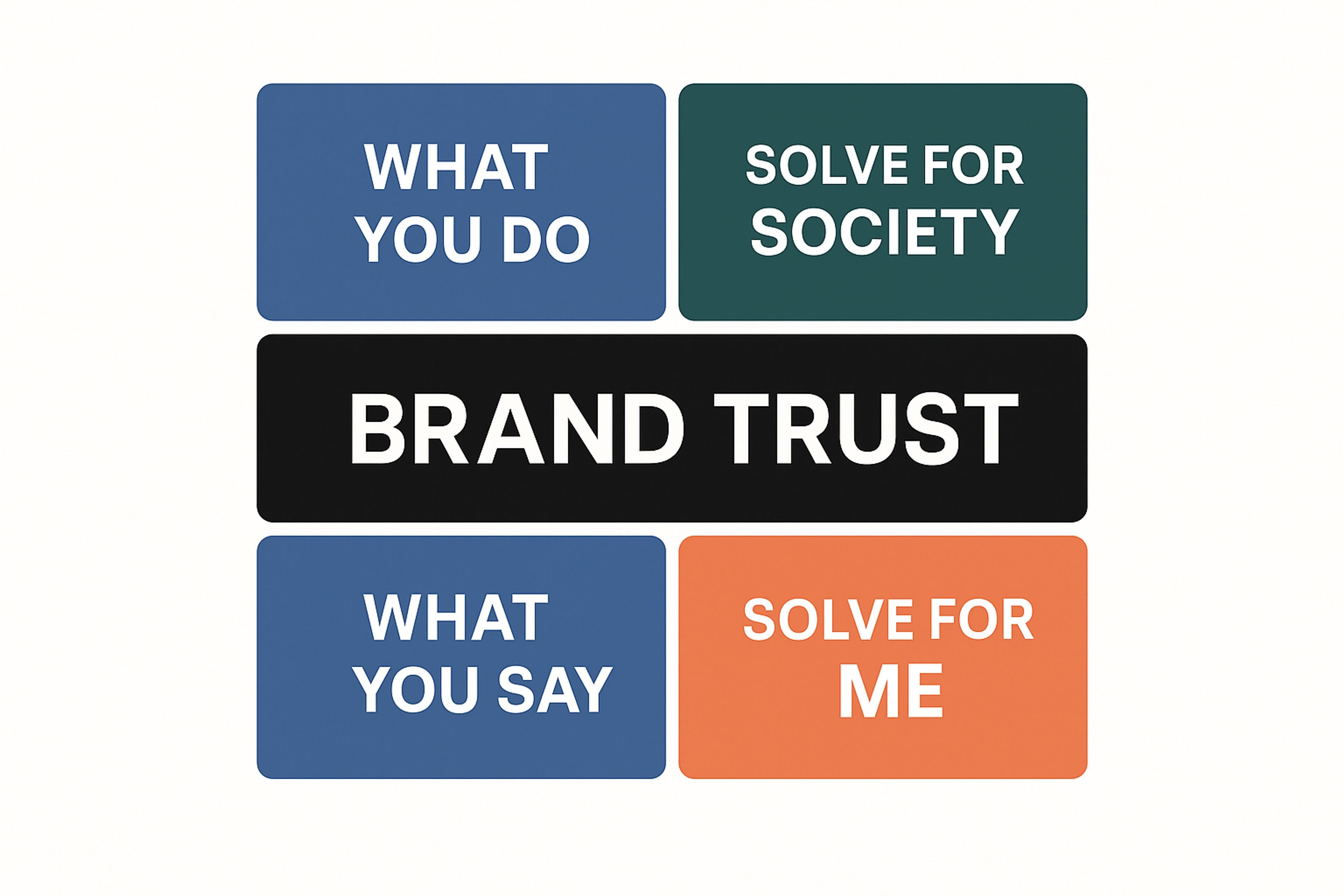
Increases Engagement
Research conducted by OneSpot reveals that personal storytelling can increase branded content engagement by up to 300%.
Integrating storytelling into branding implements narrative branding by helping businesses connect with customers through engaging, relevant content. Sharing stories and visuals grabs attention and keeps users engaged longer, while building emotional connections with the audience. This strategy develops storytelling capabilities that drive results.
A compelling brand story, with personal anecdotes or experiences, can construct brand narrative that resonates deeply and boosts engagement over time. By understanding customer motivations, brands can craft brand storytelling architecture that meets their audience's needs and interests.
Interactive methods like quizzes or polls can further engage customers, gather feedback, and strengthen relationships. Storytelling is also crucial as businesses shift to visual content like videos, helping them reach larger audiences.
By offering unique, attention-grabbing content, brands can carve out a niche and unlock new opportunities for success. A solid narrative architecture foundation makes these efforts more effective.
Storytelling Benefits by Clay
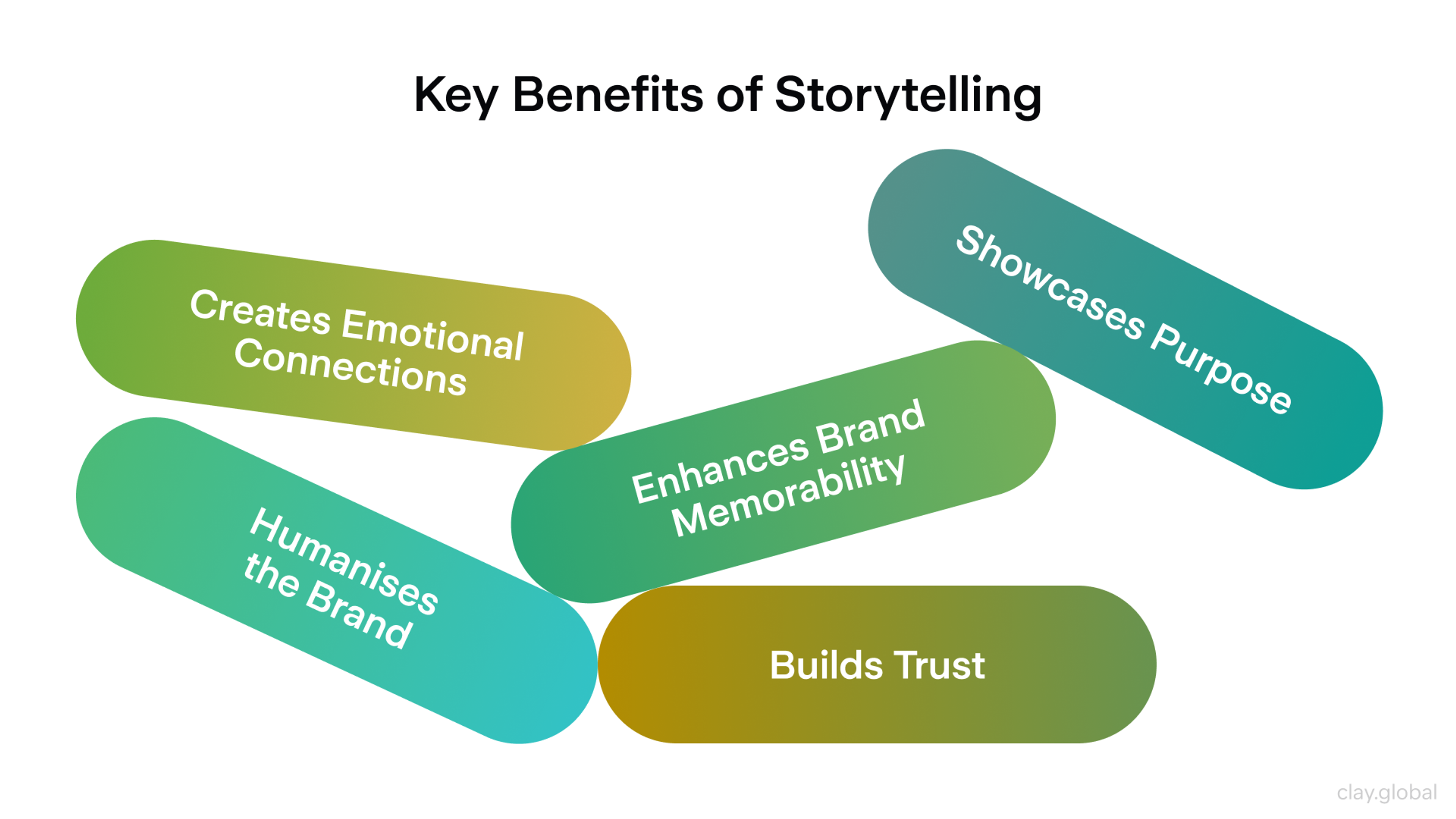
Types of Brand Stories
Founder Stories
One powerful way to connect with customers is to share the story of how your company began. When people learn about the challenges, obstacles, and breakthroughs that led to your company's creation, they feel closer to your brand. You're no longer just a faceless business - you're real people with real struggles and real victories.
Founder stories reveal the why behind your business. They show the passion that drove you to start, the problems you wanted to solve, and the vision that keeps you going. This authenticity helps customers trust you more deeply.
Customer Stories
Real customer experiences create powerful connections. When you share testimonials about how people found value in your products or services, potential customers see themselves in those stories. Sharing success stories helps customers feel more confident in their decisions, as they can relate to real-life outcomes and imagine their own success with your brand.
Customer stories also highlight your company's positive impact beyond sales and revenue. When you share real stories and invite customers to be active participants in your brand's narrative, you foster deeper engagement.
You could support local communities or champion essential causes. Sharing these success stories not only showcases your commitment to making a difference but also inspires others and builds a sense of community among those who share your values.
Employee Stories
Your team members have stories worth telling. By showcasing employee experiences, accomplishments, and personal journeys, you demonstrate that your company values and invests in its people. You're not just selling products - you're building a culture where talent thrives.
Employee stories help customers connect with your brand on a personal level, fostering loyalty and engagement. They also communicate your mission and values through the authentic voices of the people who live them every day.
Social Impact Stories
Stories about making a positive difference create meaningful connections with customers. When you show how your company improves lives or protects the planet, you not only forge emotional ties that go deeper than transactions, but also communicate your brand's commitment to its core values.
These stories include donating to those in need, supporting causes that matter, or reducing environmental impact. Sharing these stories helps build a sense of shared values and experiences with your audience, enabling people to understand what your company stands for and why they can trust you, ultimately fostering stronger relationships along the way.
The Social Impact Storytelling wheel
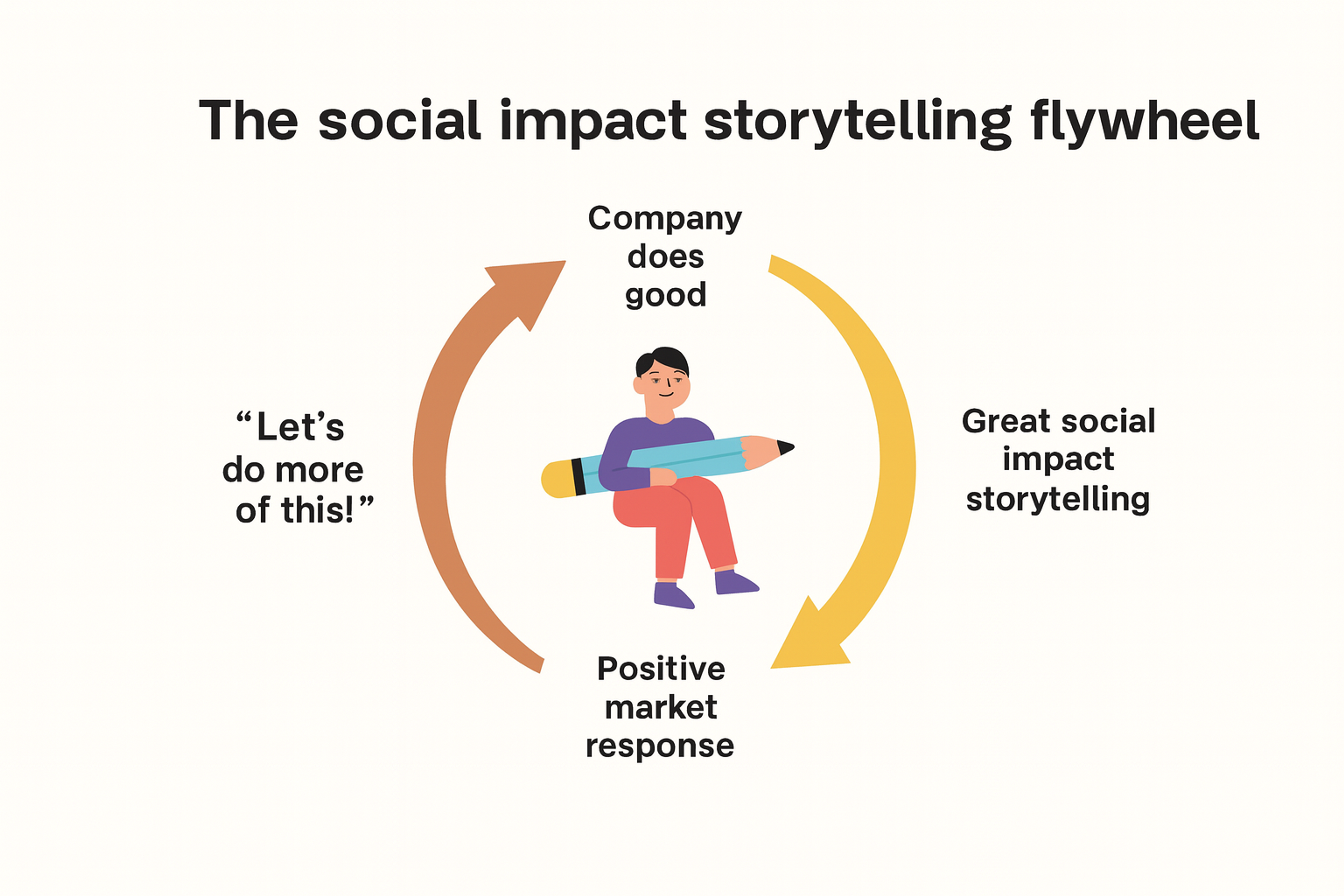
How to Create Your Brand Story
Crafting a compelling brand story starts with understanding your values, mission, and purpose. Developing a storytelling strategy that aligns with your business objectives is essential to ensure your narrative is both authentic and compelling.
You need a narrative that resonates with your target audience and reflects who you truly are - your own brand story. A strong content strategy integrates your own brand story into all marketing efforts, ensuring consistency and impact across every channel.
Start with Your Origin
Your origin story lays the foundation for everything else. How did your brand come to be? What drives your mission and shapes your values? This story should feel authentic, relatable, and inspiring. Sharing your brand's history not only humanizes your company but also helps craft a compelling brand story that resonates with your audience.
Build Your Hero's Journey
Every great story follows a journey. Your customers are the heroes facing challenges, and your brand is the guide helping them succeed. This framework creates narratives people can relate to at every stage.
The hero's journey consists of three key parts: the ordinary world, where your customer starts, the call to adventure, when they discover your solution, and the transformation, when they achieve their goals. Using this structure helps you create stories that inspire people to take action.
Define Your Purpose and Values
Your purpose and values form the core of your narrative. They define what you stand for and what drives your mission. Your brand's purpose should feel clear, concise, and inspiring, reflecting the deeper reason your brand exists.
Clearly communicating your brand's values and purpose helps audiences understand what your brand stands for, ensuring your storytelling aligns with your core beliefs and resonates authentically in social and cultural contexts. Your purpose should shine through every aspect of your story.
Your values should guide every decision you make as a brand. When you clearly define these elements, you create a loyal following that believes in what you're building.
A Guide to Brand Storytelling
Develop Your Core Message
Your core message effectively highlights your mission and connects all elements. It should clearly communicate your brand's values and vision in a way everyone can understand. Think of it as the thread that ties all your content together.
When developing this message, consider what makes your story unique. Are there features that distinguish you from competitors? Do you want to inspire people with a particular vision? Answering these questions helps you craft a message that resonates deeply with customers.
To maintain quality and consistency across all narratives, use standardized story templates and integrate storytelling into various team roles, ensuring your messaging remains authentic and cohesive.
Pick Out Your Target Audience
Targeting your target audience is one of the most important steps in marketing. Knowing who you are trying to reach and why they act, what they like, and what they want will enable you to develop compelling stories.
The process begins with getting to know your potential clients and people who use your products better so that you can distinguish common features among them. Demographic data such as age, gender, location, profession, hobbies, etc., can help businesses better understand the type of people they’re targeting.
Target Audience

It also incorporates psychographic data such as values, lifestyle choices, brands’ or products’ attitudes, and media usage habits, among others, that influence consumer behavior patterns.
By gathering this information from various sources (e.g., surveys or focus groups), companies can have a clearer picture of their target audiences and, hence, be able to adjust their storytelling and marketing efforts more efficiently.
Choose Your Channels
After identifying your target audience, please select the most effective platforms to reach them. You need channels that align with your audience's habits and preferences. Choosing the proper marketing channels is crucial for effectively distributing your brand story and ensuring it reaches and engages your target audience.
Social media provides cost-effective ways to reach a large audience. Platforms like Instagram, Facebook, and YouTube let you share stories at scale. Other effective options include email campaigns, search engine optimization, and influencer partnerships. Traditional media, such as print and broadcast, remain effective for specific audiences as well.
Types of Marketing Channels

Use Visuals and Compelling Copy
Businesses must create an engaging narrative through visuals and copywriting to penetrate their target, including departments like human resources. Companies should embed visuals in their storytelling as they are a powerful way to grab attention, evoke emotions, and recount stories. This will help take advantage of every opportunity that interests the viewer.
Copywriting plays a key role in storytelling. Companies should use simple, relatable language to engage their audience while building trust through accurate and clear messaging. This includes fact-checking claims and ensuring advertising complies with legal standards, such as avoiding deceptive practices.
Technology can further enhance storytelling. AI tools optimize copy for search engines and personalize visuals based on customer preferences, making it easier to create engaging, tailored messages across multiple channels. By blending research with technology, companies can craft meaningful narratives that resonate with their audience over time.
How Data Shapes Brand Stories
Data brings precision to storytelling. It helps brands craft messages that feel timely, relevant, and personal. Companies that analyze trends and user behavior discover what their audience truly cares about.
When used wisely, data transforms storytelling from guesswork into a strategic approach. Tools that track engagement and performance help you refine content and tailor stories to different audience segments. This approach fosters stronger connections and delivers tangible results.
Measuring Your Storytelling Success
Track how well your stories connect with your audience. Monitor engagement rates, website traffic, and social media metrics to see what's working.
Regular surveys and focus groups provide valuable feedback. They reveal how people perceive your stories and what emotional connections they create. Utilize these insights to refine your approach and make more informed decisions.
Creating Emotional Connections Through Stories
Emotional connections form the foundation of strong customer relationships. Storytelling fosters human connection by engaging audiences on a personal and emotional level, creating authentic bonds that go beyond simple transactions. Use vivid imagery, metaphors, and personal anecdotes to evoke feelings that make your brand memorable by connecting with customers on an emotional level.
Customer-generated content adds authenticity and credibility. When people share their own experiences with your brand, it strengthens emotional ties and makes your story more relatable.
Showcase your commitment to social and environmental causes that align with your values. This resonates with customers who share the same concerns, fostering deeper loyalty.
Influencer partnerships help you reach new audiences authentically. When influencers share your story, they create emotional connections with their followers that extend your brand's reach and impact.
Your employees and brand ambassadors humanize your company. When they share positive experiences, people see the real humans behind your brand, making it more trustworthy and relatable.
Customer testimonials provide proof of your impact. Real examples of how your brand helps people build trust and create emotional connections that drive long-term loyalty.
Compelling Brand Storytelling Examples
Patagonia’s Environmental Activism
Patagonia is known for its environmental activism. For over forty years, this outdoor apparel and gear company has committed itself to “causing no unnecessary harm” in all its products and practices concerning the environment.
Patagonia has undertaken various initiatives aimed at reducing its environmental footprint, such as using organic cotton, among other natural fabrics, in making clothes that can be recycled or upcycled when worn out.
The company has also turned to social media platforms to share different climate change impacts, like these ones on global warming. It regularly posts pictures on Instagram by founders and employees using Patagonia products outdoors, supporting key environmental causes and creating an interesting storyline that touches people.
Source: Patagonia

Grado Labs
Grado Labs, founded in 1953 in a Brooklyn basement by Joseph Grado, is a family-run audio company known for handcrafting high-quality headphones and phono cartridges. Passed down through three generations, the brand has stayed true to its roots — favoring craftsmanship over mass production.
With minimal advertising, Grado’s story spreads through word-of-mouth and a loyal audiophile community. It’s a brand built on heritage, authenticity, and a passion for preserving the soul of sound.
Source: gradolabs.com

Drift
Founded in 2015, Drift set out to humanize B2B sales by replacing clunky forms with real-time, conversational marketing. Co-founders David Cancel and Elias Torres believed buyers didn’t want to be sold to — they wanted to be heard.
Drift pioneered a new way of connecting through chat and AI, making B2B feel personal. Now part of Salesloft, their mission remains the same: create more human, meaningful customer experiences.
Source: salesloft.com
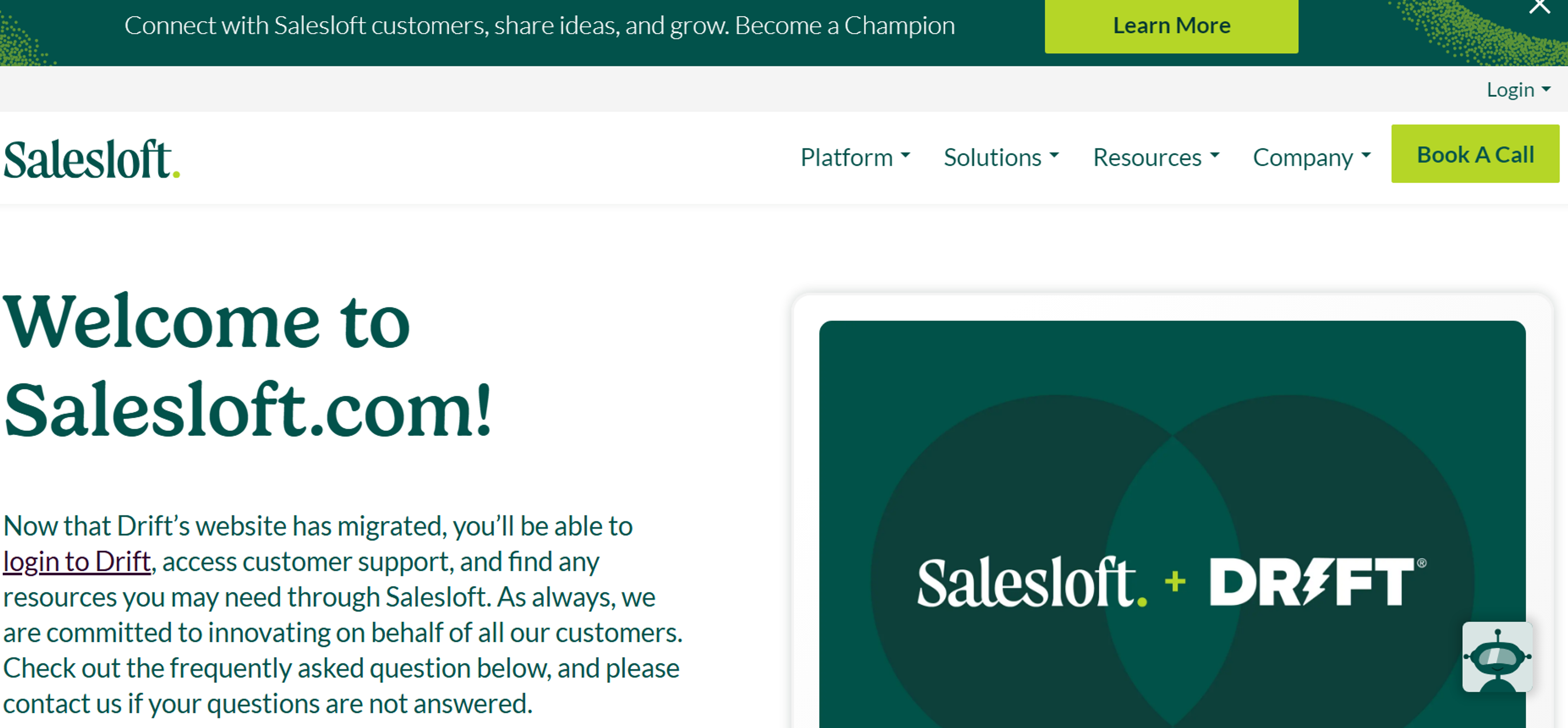
Brand Storytelling Framework
A great brand story connects emotionally with your audience. Here’s a concise framework with three key sections to create an impactful narrative:
Define Your Brand’s Purpose
- Why it matters: Your brand’s purpose is the foundation of your story. It explains why your brand exists and what problem it solves.
- Action: Clarify your mission and values to shape a story that reflects these core elements.
Know Your Audience
- Why it matters: A story that resonates with your audience drives deeper connections.
- Action: Research your target audience’s needs and preferences to ensure your message speaks to them directly.
Create the Narrative
- Why it matters: A clear, structured story keeps your audience engaged.
- Action: Use the classic story arc: the hero (your brand), the problem, the solution, and the transformation.
Hero Journey Framework by Clay
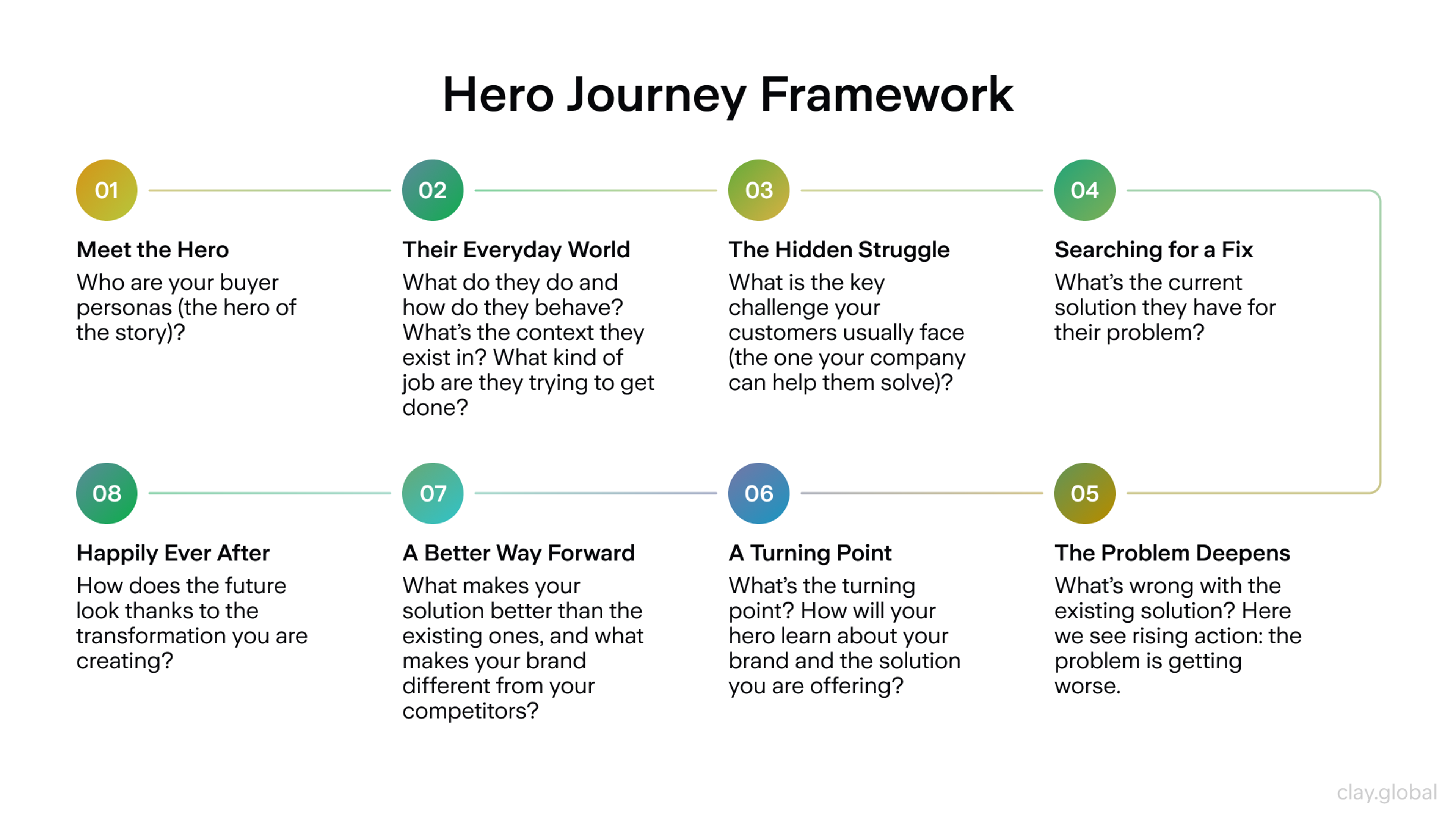
Brand Storytelling Tools
Effective brand storytelling requires the right tools to create, manage, and distribute your message. Here are three essential tools to help you craft your brand narrative.
Canva
- What it does: Canva is a design tool that helps create stunning visuals for your storytelling campaigns. It’s perfect for creating graphics for social media, blogs, or marketing materials.
- Why it’s useful: Strong visuals are crucial for telling a compelling brand story. Canva makes it easy to design high-quality content that aligns with your brand’s voice.
BuzzSumo
- What it does: BuzzSumo helps you track trending content and analyze what resonates with your audience across the web.
- Why it’s useful: By identifying popular topics, BuzzSumo ensures your brand story stays relevant and engaging, helping you create content that grabs attention.
Hootsuite
- What it does: Hootsuite is a social media management platform that allows you to schedule, manage, and track your brand’s social media content.
- Why it’s useful: Social media is key to brand storytelling. Hootsuite helps you maintain a consistent narrative across all platforms, ensuring your message reaches the right audience at the right time.
These tools enable you to design eye-catching visuals, stay on top of trends, and maintain a strong, consistent brand story online.
Read More
Conclusion
Businesses have countless options for crafting stories that resonate with customers. From social media platforms and content marketing to engaging visuals and compelling copy, opportunities abound.
Modern technology amplifies these efforts through tools that help optimize messages and personalize content based on customer preferences. By combining authentic storytelling with innovative technology, companies create meaningful experiences that build stronger relationships over time.
The brands that thrive tomorrow will be those that master storytelling today. Start with your why, know your audience deeply, and tell your truth consistently. Investing in brand storytelling helps future-proof your business in a rapidly changing marketplace. Your story is waiting to be told.


About Clay
Clay is a UI/UX design & branding agency in San Francisco. We team up with startups and leading brands to create transformative digital experience. Clients: Facebook, Slack, Google, Amazon, Credit Karma, Zenefits, etc.
Learn more

About Clay
Clay is a UI/UX design & branding agency in San Francisco. We team up with startups and leading brands to create transformative digital experience. Clients: Facebook, Slack, Google, Amazon, Credit Karma, Zenefits, etc.
Learn more


